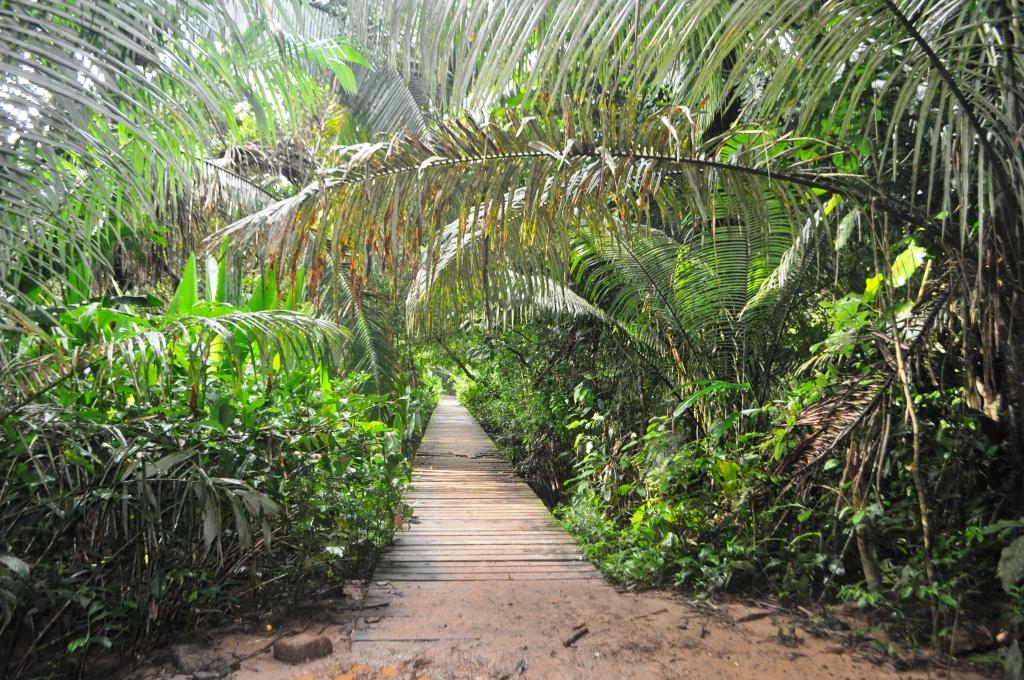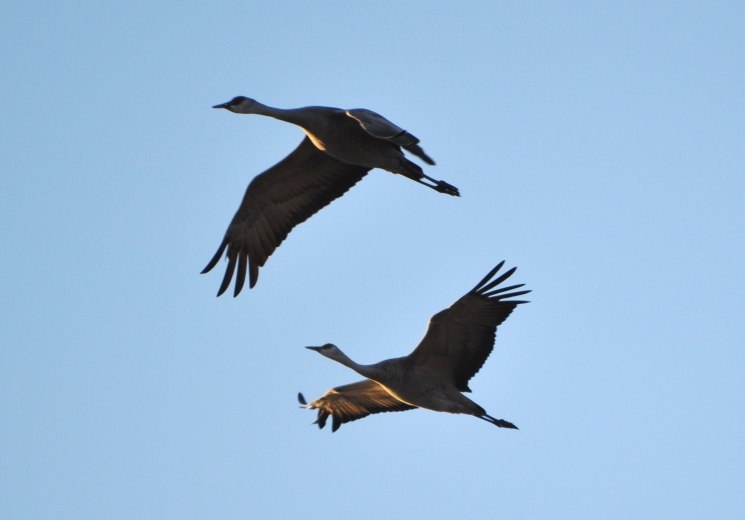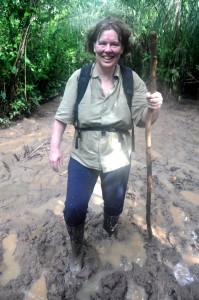
I’d been trudging through the Amazonian mud for hours. What had been described as a three or four-mile round-trip clocked in at more than six miles according to an iPhone app that by some miracle operated in a place where there were no power lines, no roads, no engines, no homes.
And we weren’t going fast. When I say mud, I don’t mean some gentle little suburban puddle you can daintily step around; I mean sticking, clinging, jungle mud; the kind of mud that pulls gum boots off of feet and leaves skid marks in your slurping, sucking, sliding wake.
I should interrupt myself here to note that this is the sort of thing I think of as “fun.”
I was hiking with a group of a dozen travel writers, aged mid-30s to 70-plus, and not everyone had their mud-stomping muscles in good working order. According to our guide, one of us moved as “slow as a sloth,” a comparison that seemed a little unkind, as the only sloth we’d thus far seen appeared to have no intention of moving at all, ever. But no matter: Everyone was in good spirits, and it wasn’t as if we had a business meeting to get back in time for.
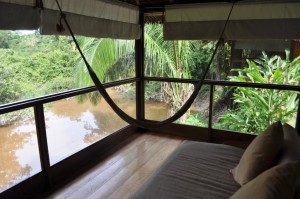
I was staying at Inkaterra’s Reserva Amazonica, an ecolodge situated about a half an hour’s boat ride from the bridge at Puerto Maldonado. Outfitted with a provincial airport, Puerto Maldonado is the embarkation point for trips into Peru’s southern Amazon basin along the Madre de Dios River, one of the richest and most diverse ecological zones in South America. One of the key biodiversity areas is the Reserva Nacional de Tambopata, which boasts 1,234 species of butterflies, 592 of birds, 127 of amphibians, 103 of mammals, and 74 of reptiles. Inkaterra, an ecotourism operator that offers eco-luxury with a zero-carbon footprint, has been operating in the Amazon for 40 years, making it one of the region’s pioneers in sustainable tourism.
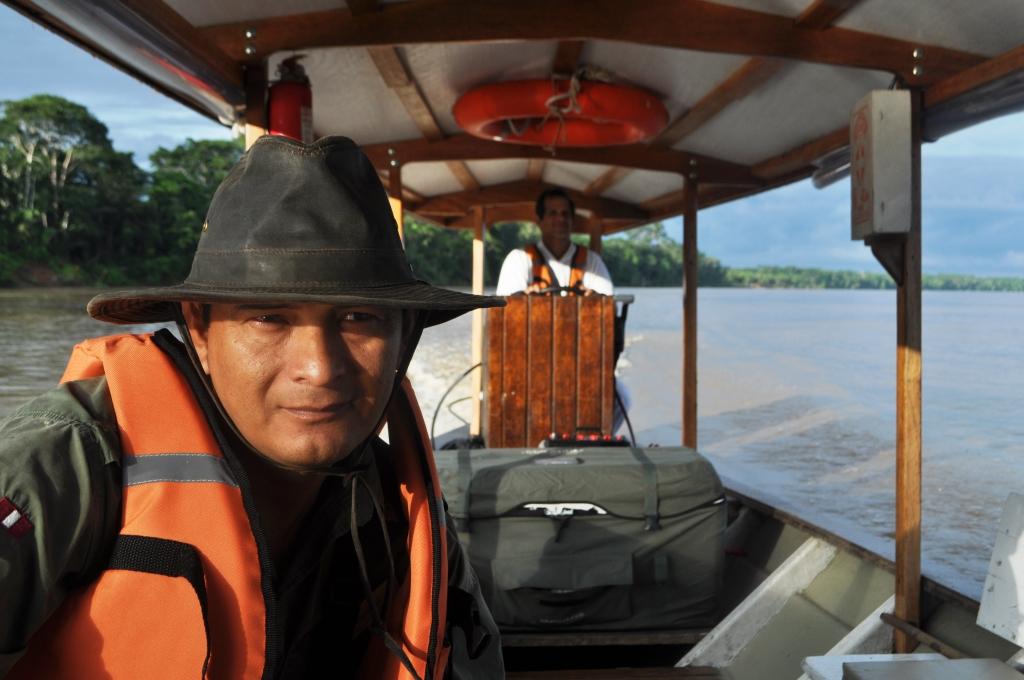
Our mud-walk was to take us from the dock on the river, about a half an hour from the lodge. It began with a scramble up a short embankment that immediately got my attention. Fortunately previous walkers had left some discarded hiking sticks in the mud, and I grabbed one, which immediately improved my balance, my outlook, and my odds of staying upright.
The other indispensable piece of gear was footwear: knee-high rubber gum boots provided by the lodge. In the 90-degree heat, I’d opted for the slightly larger of the two pairs I’d tried on. This was a good decision: They were surprisingly comfortable, and, in the foot-swelling heat, I was thrilled to feel no pressure spots that might turn into blisters farther down the line. Even if I’d brought blister stuff with me — my usual first aid kid contains Second Skin, adhesive tape, and scissors — I’d have had a hard time finding a place to sit down and apply it.
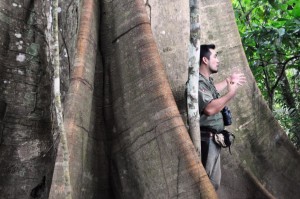
The trek took us through primary rainforest: Some of the trees along the trail were more than 1000 years old according to Carlos, our guide. But the most impressive was a 300-year old “young” one — a ficus with the girth of a western redcedar. It barely fit into the frame of my camera.
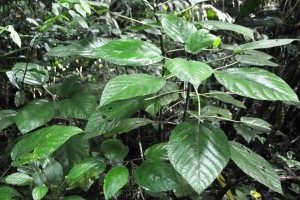
Carlos stopped occasionally to point out shrubs and trees that provide fruits and leaves that are traditionally used for food and medicine, as well as a plant he referred to as “poison ivy,” but which, with its broad flat leaves and tiny hairs, looks like our North American stinging nettles. I didn’t touch it to find out. We paused to catch glimpses of a few birds — macaws, mostly — but to be honest, our eyes were mostly on our feet, which is why most of us took note of the rows of leaf-cutter and army ants that were busy going about their jobs for the day. Only when the howler and squirrel monkeys flew past, crashing through the canopy with reckless abandon, did we look up: That got out attention away from our feet and onto our cameras.
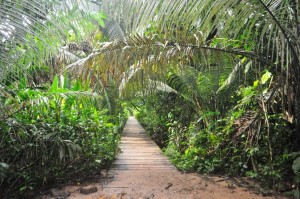
I won’t lie: This hike isn’t for everyone, at least not in the rainy season. There are no dry spots, and most of us ended up with our butts in the mud at least once. This is a land that floods easily and often: At an elevation of only about 600 feet above sea level, we were far inland from the river’s eventual drainage into the Atlantic Ocean, still thousands of river miles away. So the water, having nowhere to go, creates a flooded-forest habitat that is the most extensive example of this type of habitat in the world. Along the banks of the Madre de Dios River, you can see where floods have torn away at the banks.
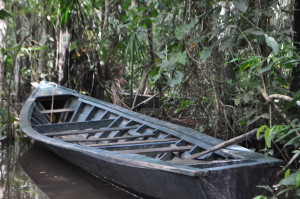
Two or three miles in, depending on whether you trust the guide or the GPS, we came to a marsh where painted wooden boats were tied to a dock. The man handling the boats, we were told, once fought his way out of the unhinged jaws of a 7-meter long anaconda. The boatman, small and tough-looking, stood knee-deep in the swamp. I didn’t know know if this was a tall tale, and if so, how tall a tale it might have been. Alert to the possibility of reptilian company, my eyes scanned the jungle, but it was hard to see what might have been lying just in back of that shrub, or beneath that vine. Even at a distance of a few meters, the bright orange howler monkeys and the extravagantly plumed macaws, parrots, and herons. faded into the brush, invisible in plain sight.
We climbed into the dugout canoe. Its tippiness might have been normal for a canoe , but when a canoe is tippy in a swamp said to house caimans and giant anacondas, it seems somehow more precarious. We stayed still as the guide silently floated us on the watery path among the vegetation. A few minutes later, we left the swamp for the lake, which opened wide in front of us, fringed by its halo of jungle.
We paddled along the shore looking for the residents: endangered giant river otters (Pteronura brasiliensis), blue and yellow macaws (Ara ararauna), red howler monkeys (Alouatta seniculus), black caimans (Melanosuchus niger), and a host of bird-life, especially herons and egrets. More howler monkeys crashed through the canopy. A heron stood motionless, cooperatively posing. We didn’t see river otters or caimans. There’s another ecolodge on the lake, hidden in the vegetation somewhere, and we didn’t see that, either. The jungle, hides, camouflages, obliterates.
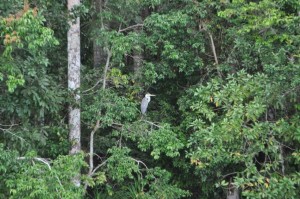
After an hour or so, Carlos miraculously guided our boat back into the same clump of vegetation from which we had entered the lake, and we glided over the still, brown water to the dock. The walk back was the same as the walk forward, but shorter somehow, as it always seems to be.
If we’d known what was in our immediate future, we’d have walked even faster: The cold Cusqueno cervezas waiting for us in the boat back at the river were perhaps the best any of us had ever tasted.
